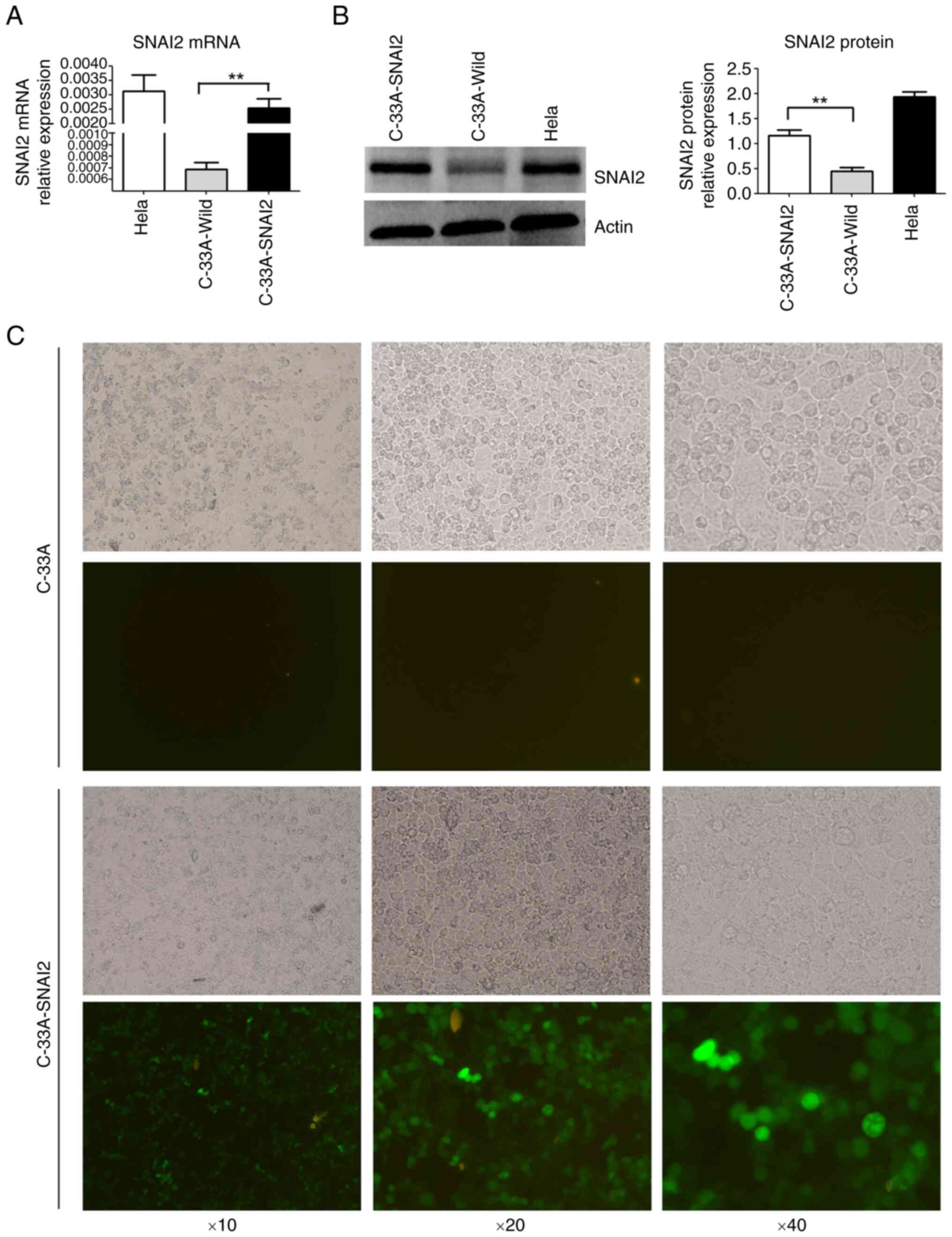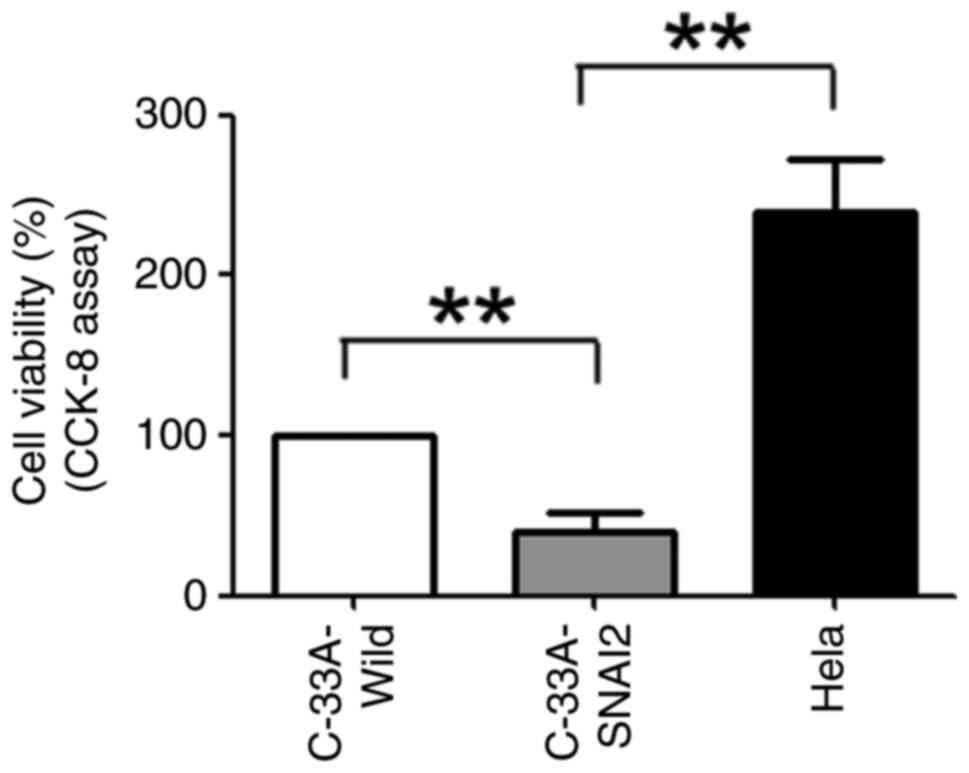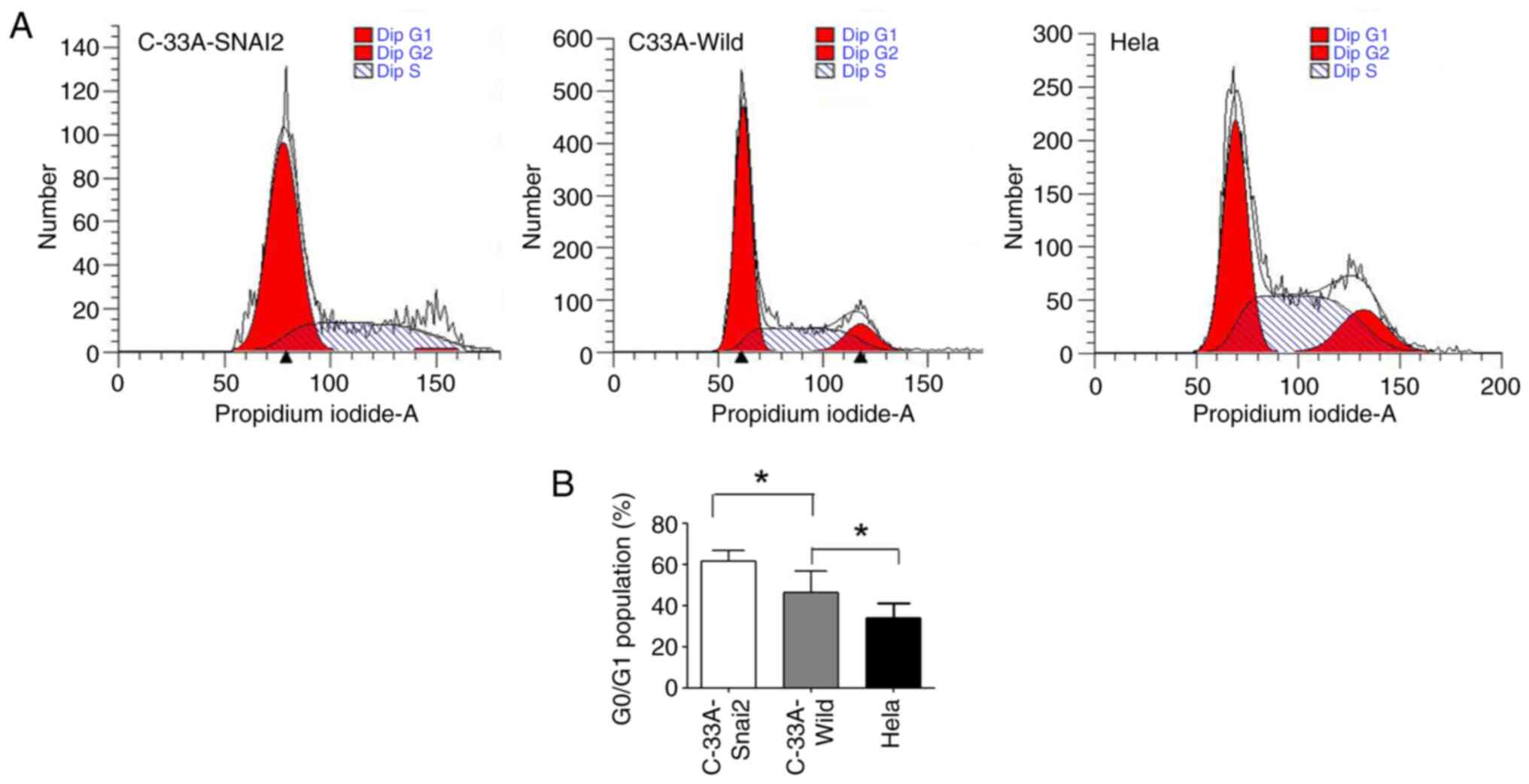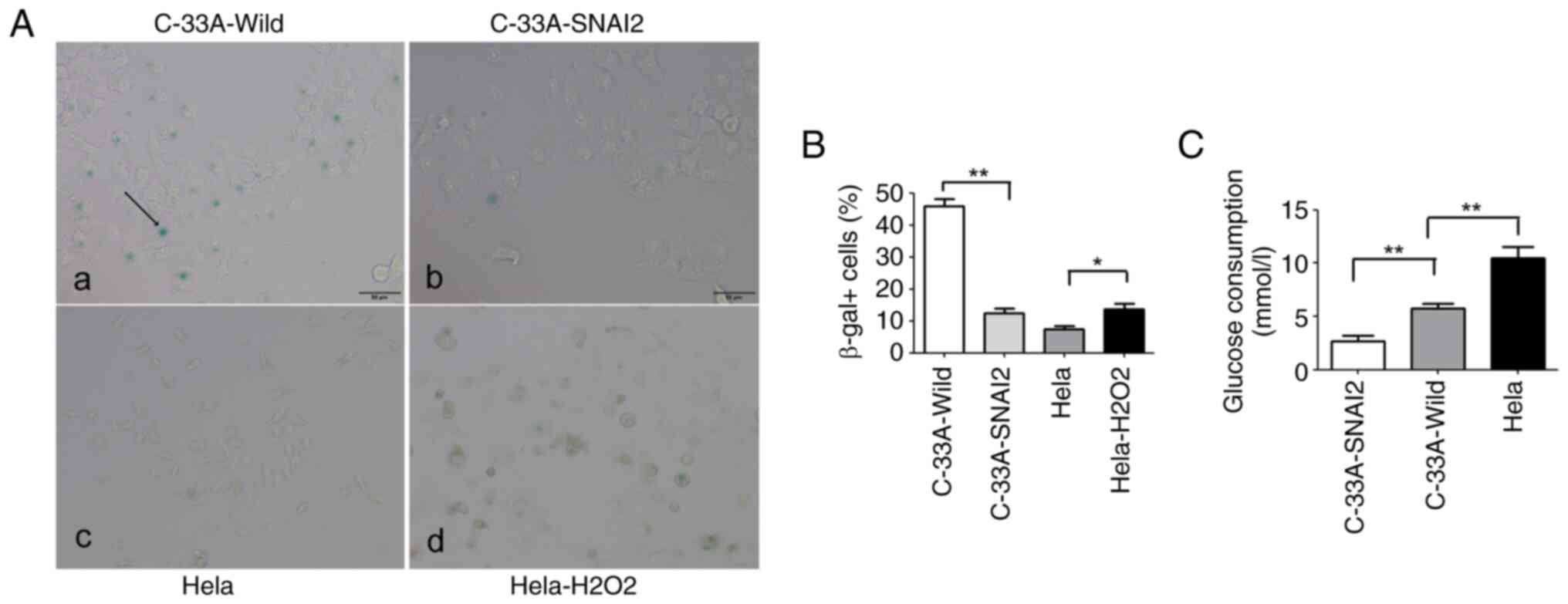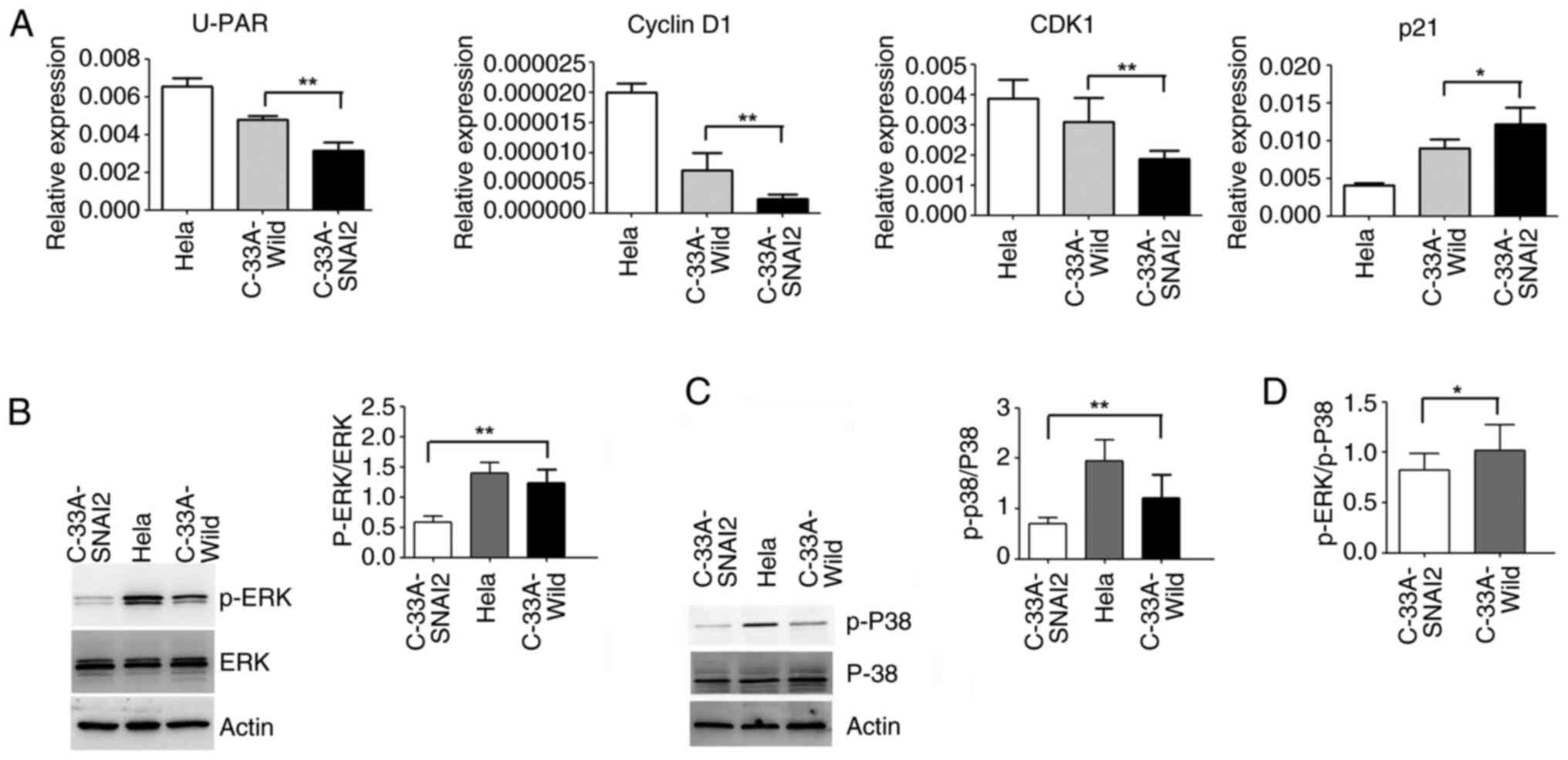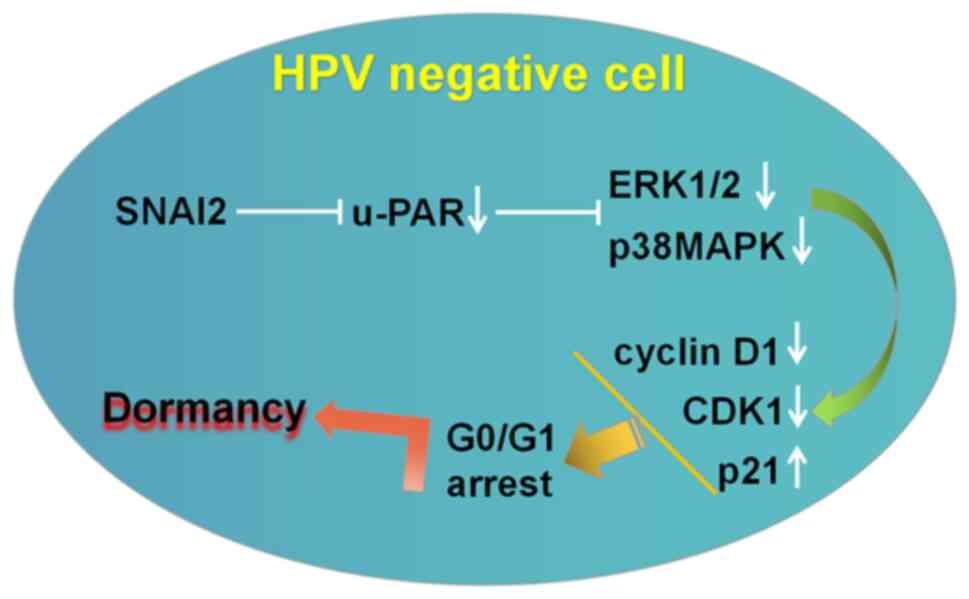SNAI2 enhances HPV‑negative cervical cancer cell dormancy by modulating u‑PAR expression and the activity of the ERK/p38 signaling pathway in vitro
- Authors:
- Published online on: June 27, 2024 https://doi.org/10.3892/or.2024.8763
- Article Number: 104
-
Copyright: © Zhou et al. This is an open access article distributed under the terms of Creative Commons Attribution License.
Abstract
Introduction
Globally, cervical cancer is the third most common tumor and the fourth most common cause of cancer-related death in women (1). The 5-year survival rates for progressive cervical cancer are low, at ~55%, and these rates range from 26.7–56% for recurrent cervical cancer (2). The majority of cervical cancer cases are associated with certain types of high-risk types of human papillomavirus (HPV) infection (3). However, 3–8% of cervical cancer cases are persistently HPV-negative (4). In addition, patients with HPV-negative cervical cancer have a worse prognosis than patients with HPV-positive cervical cancer (4).
Cancer recurrence and metastases are associated with cancer dormancy, and are the leading cause of cancer-related death in patients (5). Cancer dormancy may explain for tumor refractoriness and the phenomenon that initial treatment of the primary tumor cannot cure the malignancy (6). Previous studies by the authors confirmed that breast cancer cells seeded at metastatic sites had a lower proliferative potential and remained quiescent over a long period of time (7); then, after a long time, they resumed active growth and progression when the microenvironmental conditions of the metastatic site shifted to support tumor expansion (8). Therefore, illuminating the mechanisms regulating dormancy is critical for defending against disease recurrence in patients with HPV-negative cervical cancer.
The snail family transcriptional repressor 2 (SNAI2) gene is an evolutionarily conserved C2H2 zinc finger protein that coordinates biological processes critical for tissue development and tumorigenesis (9,10). It is a ubiquitous phenomenon that SNAI2 is aberrantly expressed in human cancers and clearly indicates poor prognosis in patients with cancer (9,11,12). Upregulated expression of SNAI2, or its dysregulation, suggests malignant characteristics during cancer progression (9–11,13). In addition, SNAI2 plays a prominent role in tumor proliferation, metastasis and angiogenesis (8). However, the role of SNAI2 in dormancy, especially that of HPV-negative cervical cancer cells, has not been fully elucidated. Therefore, the present study investigated whether SNAI2 participated in HPV-negative cervical cancer cell dormancy. The present study indicated that SNAI2 enhanced HPV-negative cervical cancer cell dormancy, which was characterized by G0/G1 arrest, by downregulating the expression of urokinase plasminogen activator receptor (u-PAR), the activity of the ERK1/2 and p38MAPK signaling pathways, and by further regulating the expression of proliferation-associated genes (downregulation of cyclin D1 and CDK1, upregulation of p21 expression) in vitro. Interference with this process may provide new therapeutic strategies for inhibiting the metastatic switch from dormancy to proliferation.
Materials and methods
Cells and reagents
The cervical cancer C33A (HPV-negative) and HeLa (HPV-positive) cell lines were purchased from the Type Culture Collection of the Chinese Academy of Sciences, and maintained in Dulbecco's modified Eagle's medium (Gibco; Thermo Fisher Scientific, Inc.) with high glucose, 10% fetal bovine serum (Gibco; Thermo Fisher Scientific, Inc.). The cells were maintained in 6-cm plates at 37°C in an incubator with 5% CO2. The C-33A-Wild group are untransfected C-33A cervical cancer cells.
Cell transduction
To induce upregulation of SNAI2, the coding sequences of SNAI2 was synthesized and cloned into the GV367 overexpression plasmids by JIKAI GENE Company (https://www.genechem.com.cn/). Subsequently, lentiviruses were produced by transfecting the 293T cells using Lipofectamine 2000 (cat. no. 11668019; Thermo Fisher Scientific, Inc.) with GV367-Ctrl and GV367- SNAI2 vectors. After 48 h, the virus supernatants were harvested, filtered and concentrated. Subsequently, the lentiviruses were added to the medium, supplied with 5 µg/ml polybrene (cat. no. REVG0001; JIKAI GENE; http://www.genechem.com.cn/) to infect the C-33A cells at 37°C in an incubator with 5% CO2 for 96 h. Multiplicity of infection was 20. Finally, the cell lines with a stable overexpression were constructed by treating the cells with 2.5 µg/ml puromycin (cat. no. HB-PU-1000; Hanbio Biotechnology Co., Ltd.) for 2 weeks.
Gene expression assessed by reverse transcription-quantitative polymerase chain reaction (RT-qPCR)
RNA was extracted from cells with TRIzol® reagent (Invitrogen; Thermo Fisher scientific, Inc.). The relative quantity of mRNA was determined by RT-qPCR, as previously described (8). The primer sequences were as follows: SNAI2 sense, 5′-AGGAATCTGGCTGCTGTG-3′ and antisense, 5′-GGAGAAAATGCCTTTGGAC-3′; Cyclin D1 sense, 5′-CAGATCATCCGCAAACACG-3′ and antisense, 5′-GGGACATCACCCTCACTTAC-3′; u-PAR sense, 5′-GAGCTATCGGACTGGCTTGAA-3′ and antisense, 5′-CGGCTTCGGGAATAGGTGAC-3′; CDK1 sense, 5′-AAACTACAGGTCAAGTGGTAGCC-3′ and antisense, 5′-TCCTGCATAAGCACATCCTGA-3′ p21 sense, 5′-GGACAGCAGAGGAAGACCATGT-3′, and antisense, 5′-TGGAGTGGTAGAAATCTGTCATGC-3′; and GAPDH sense, 5′-TCATTGACCTCAACTACATGGTTT-3′ and antisense, 5′-GAAGATGGTGATGGGATTTC-3′.
Cell cycle analysis by flow cytometry
The tumor cells (1.0×105/well) were cultured in 6-well plates for 3 days, and were then analyzed using propidium iodide (Molecular Probes; Invitrogen; Thermo fisher scientific, Inc.) to discriminate non-viable cells. DNA synthesis or the total DNA content were measured by flow cytometry using a FACSCalibur flow cytometer (BD Accuri™ C6; BD Biosciences). FlowJo software (version 7.6.1; FlowJo LLC) was used for analysis of the results.
Glucose consumption detected by oxidase assay
The tumor cells (1.0×103/well) were cultured in 96-well plates for 2 days. The glucose consumption in cervical cancer cells, with or without upregulation of SNAI2, was detected by oxidase assay (cat. no. 09000238813; Shanghai Rongsheng Biotech Co., Ltd.), according to the manufacturer's protocol.
Senescence assay by senescence-associated beta-galactosidase (SA-beta-Gal) staining
The cells (C-33A-Wild, C-33A-SNAI2, HeLa and HeLa-H2O2) were plated at a density of 3×103 cells/well in 10% FBS-containing medium. The HeLa-H2O2 group cells were prepared by incubating the cells with 0.9908 mmol/l H2O2 at 37°C for 4 h. The senescence of tumor cells was detected by SA-beta-Gal staining at room temperature for 15 min (cat. no. C0602; Beyotime Institute of Biotechnology), according to the manufacturer's protocol.
Cell Counting Kit-8 (CCK-8) proliferation assay
The cells (1×103/well) were resuspended in 100 µl 10% FBS-containing medium and were cultured on plates for 24 h. The CCK-8 assay (WST; Dojindo Laboratories, Inc.) was then used to measure cell proliferation according to the manufacturer's protocol. The cells were incubated with 10 µl CCK-8 buffer and 90 µl of DMEM at 37°C for 4 h. The OD value was then measured at 450 nm.
Western blot assay (WB)
WB was performed as previously described (8). Total protein was extracted from the cells using RIPA buffer (Thermo Fisher Scientific, Inc.). The protein concentration was measured using the Bradford Protein Assays (Thermo Fisher Scientific, Inc.). A total of 40–70 µg proteins were then separated by SDS-PAGE on 12% gels, followed by transfer onto PVDF membranes. The PVDF membranes were blocked with 5% non-fat milk and incubated with primary antibodies [SNAI2 (1:1,000; cat. no. sc-166476; Santa Cruz Biotechnology, Inc.), ERK1/2 (1:1,000; cat. no. sc-514302; Santa Cruz Biotechnology, Inc.), phosphorylated (p-)ERK1/2 (1:2,000; cat. no. sc-7976; Santa Cruz Biotechnology, Inc.), p38 (1:1,000; cat. no. 9212; Cell Signaling Technology, Inc.), p-p38 (1:1,000; cat. no. 9211; Cell Signaling Technology, Inc.) and β-actin (1:2,000; cat. no. 4967; Cell Signaling Technology, Inc.)] at 4°C overnight. After washing with PBS-Tween (Beyotime Institute of Biotechnology), the membranes were incubated with secondary antibodies for 2 h at room temperature. All bands were washed in TBS with 0.05% Tween-20 and immunoblotted with peroxidase-conjugated anti-mouse or anti-rabbit secondary antibodies, respectively. The bands were detected using an enhanced ECL-Plus kit (cat. no. P1010-25; Applygen Technologies, Inc.) and exposed to film. ImageJ 2019 (National Institutes of Health) was used for densitometry. Actin protein was used for all western blotting as a loading control.
Statistical analysis
Results were expressed as the mean ± standard deviation of three independent experiments with a total of six samples and interpreted by one-way ANOVA followed by Tukey's post hoc test. P<0.05 was considered to indicate a statistically significant difference. SPSS software (version 17.0; SPSS, Inc.) was used for statistical analyses.
Results
Establishment of HPV-negative cervical cancer cells with stable expression of SNAI2
SNAI2 expression was detected using RT-qPCR and WB in cervical cancer cell lines. A high level of SNAI2 expression was detected in the HPV-positive cervical carcinoma HeLa cell line, but almost no SNAI2 expression was detected in the HPV-negative cervical carcinoma C-33A cell line (Fig. 1A and B).
To further investigate the function of SNAI2 in HPV-negative cervical cancer cells, exogenous SNAI2 was stably overexpressed in C-33A cells (C-33A-SNAI2) using GV367-SNAI2 lentiviral particles, and expression was determined using RT-qPCR, WB and fluorescence microscopy (Fig. 1C). The results showed that the mRNA and protein expression levels of SNAI2 were high in C-33A-SNAI2 cells (Fig. 1).
SNAI2 promotes HPV-negative cervical cancer cell dormancy in vitro
To investigate whether SNAI2 expression promoted the dormancy of HPV-negative cervical cancer cells, C-33A-Wild, C-33A-SNAI2 and HeLa cells were first cultured for 24 h, and cell proliferation was tested using the CCK-8 method. The results revealed that the viability of C-33A-SNAI2 cells was significantly lower than that of their respective control cells (C-33A-Wild and HeLa), indicating that upregulation of the SNAI2 gene suppressed the proliferation of HPV-negative cervical cancer C-33A cells (Fig. 2).
It was further investigated whether the upregulation of SNAI2 affected the cell cycle regulation in HPV-negative cervical cancer C-33A cells. The present results revealed that a high percentage of HPV-negative cervical cancer C-33A cells remained in the G0/G1 phase, with a smaller S and G2/M cell population, when SNAI2 expression was upregulated, suggesting that the cells remained arrested at G0 phase (Fig. 3). In addition, HPV-positive cervical cancer HeLa cells maintained the highest viability, with the smallest population in the G0/G1 phase. In conclusion, SNAI2 may administrate difference function in HPV-positive and HPV-negative cervical cancer cells.
All of these results demonstrated that overexpression of the SNAI2 gene inhibited the proliferation of HPV-negative cervical cancer cells by inducing cell cycle arrest during the G0/G1 phase of the cell cycle.
Senescence plays a fundamental role in some age-related diseases, such as osteoarthritis, glaucoma, diabetes and cancer (14). The critical characteristic for senescence is cell cycle arrest; and senescent cells exhibit permanent proliferation arrest with increased expression of cell cycle inhibitors (15), meaning that senescent cells cannot restart proliferation after release from cell cycle arrest (14,15).
To further examine whether SNAI2-mediated C-33A cell cycle arrest was due to the promotion of cell entry into dormancy or senescence, tumor cells were stained for expression of the senescence marker SA-beta-Gal. It was observed that C-33A-SNAI2 cells lacked the typical morphological signs of senescence (including cell enlargement, flattening and long cytoplasmic projections), and the percentage of cells positive for the senescence marker SA-beta-Gal was significantly decreased in C-33A-SNAI2 cells, compared with that in C-33A-Wild cells, indicating that the upregulation of SNAI2 was required for the proliferating-to-dormant switch of HPV-negative cervical cancer C-33A cells via the induction of G0/G1 arrest, but not the enhancement of cell senescence (Fig. 4A and B).
Glucose plays an important role in the survival and proliferation of tumor cells, and it was previously demonstrated that the dependence of cancer cells on glucose promotes survival and cellular proliferation (16). To further identify whether the upregulation of the SNAI2 gene was involved in regulating glucose consumption in C-33A cells, glucose consumption of tumor cells was assessed using oxidase assays. The present results revealed that C-33A-SNAI2 cells had lower glucose consumption than C-33A-Wild and HeLa tumor cells (Fig. 4C).
SNAI2 regulates the expression of proliferation-related genes by suppressing the ERK/p38 pathway ratio
SNAI2 is involved in mediating the proliferation, metastasis and angiogenesis of tumors (17). SNAI2 enhances the kinase activity of cyclin D1/CDK4/CDK6, which is a central mediator in the transition from the G1 to the S phase, to further promote the switch to tumor cell proliferation (18). Therefore, SNAI2 may participate in the proliferating-to-dormant switch of tumor cells.
The u-PAR is identified in tumor cells with a high potential for invasion, metastasis, dormancy and proliferation, upon downregulation of which, the p38SAPK pathway is induced, and a G0/G1 arrest representing tumor cell dormancy is initiated (19).
To confirm the role of SNAI2 in the proliferation-to-dormancy switch of HPV-negative cervical cancer cells, the dormant tumor cells were analyzed using RT-qPCR and WB. As demonstrated in Fig. 5A, the upregulation of SNAI2 could enhance the increase in p21 expression, and the decrease in CDK1, u-PAR and cyclin D1 expression in C-33A cells, compared with that of C-33A-Wild cells.
A previous study reported that the ERK activity level and ERK/p38 activity balance are valid general predictors of tumorigenicity and dormancy, and a high ERK/p38 ratio allows for cell cycle progression and tumor growth (20). Disruption of this complex caused an inversion in the ERK/p38 ratio toward p38 signaling; a change that results in cell cycle arrest and dormancy in breast cancer, prostate cancer, melanoma and fibrosarcoma cell lines (20).
To further clarify the mechanisms underlying the determination of HPV-negative cervical cancer C-33A cell dormancy, the activation of ERK and p38MAPK was detected using WB. The results verified that the sustained activation of p-ERK and p-p38MAPK was significantly decreased when SNAI2 expression was upregulated in C-33A cells (Fig. 5B and C). The p-ERK/p-p38 ratio in C-33A-SNAI2 cells also revealed a downward trend compared with that of C-33A cells (Fig. 5D).
Discussion
Tumor cell dormancy is defined as the temporary mitotic G0/G1 arrest of tumor growth (21). In tumor mass dormancy, the number of cancer cells remains balanced between cell division and apoptosis (21). These dormant tumor cells go undetected for long periods, several years or even decades, and may explain prolonged asymptomatic residual disease and treatment resistance. Unfortunately, dormant tumor cells may eventually result in cancer recurrence and death (22). However, the mechanisms underlying the reactivation of dormant tumor cells to a proliferative state are not yet known.
Notably, aberrant SNAI2 expression is a widespread phenomenon in human cancers, which can predict poor prognosis in patients with cancer (23). In addition, it has been found to have different effects on tumor growth, recurrence and metastasis in various carcinomas (24). SNAI2 can enhance tumor cell proliferation and growth in lung cancer and glioblastoma (23), increase tumor cell recurrence and metastasis in breast cancer (8), and promote the development of ovarian cancer through regulating ferroptosis (25).
However, SNAI2 acts as an oncogene or tumor suppressor during cervical carcinogenesis (24,26). Cui et al (24) reported that SNAI2 can suppress the proliferation of HPV-negative cervical cancer cells in vitro and tumor formation in vivo. In HPV-positive cervical Siha and HeLa cells with high tripartite motif containing 62 expression, cell proliferation is inhibited when SNAI2 expression is downregulated (26). The aforementioned studies showed that SNAI2 are diverse and context-dependent, reminiscent of the various cancer types and heterogeneity of the tumor cells. Notably, the present study demonstrated that upregulation of SNAI2 expression could inhibit proliferation, and promote cell dormancy in HPV-negative cervical cancer C-33A cells. Overall proliferative capacity and glucose consumption were significantly decreased, and G0/G1 phase arrest was detected when SNAI2 was highly expressed in HPV-negative cervical cancer C-33A cells. At the same time, C-33A-SNAI2 cells lacked the typical morphological signs of senescence, and the percentage of cells positive for the senescence marker SA-beta-Gal was significantly decreased in the C-33A-SNAI2 group. Briefly, SNAI2 could enhance HPV-negative cervical cancer C-33A cell dormancy by inducing G0/G1 arrest, but not senescence, which is not only decreased cell proliferation capacity and tumor formation of cervical cancer cells (24).
A previous study showed that SNAI2 was a trigger in the regulation of breast cancer dormancy by regulating cyclin D1/CDK4/CDK6 activity (18), which involved the transition from G1 to S phase, to further promote the switch to tumor cell proliferation (20), thus indicating that cyclins may participate in the SNAI2-mediated proliferation-to-dormant switch of cervical cancer cells. Cyclins are a key factor in cell cycle turnover and initiate cell proliferation potential (27). As an inhibitory protein of CDKs, p21 mediates p53-dependent cell cycle arrest and inhibits CDK1 activity by combining the complex formed of cyclin and CDK1. p21 directly inhibits DNA synthesis, arrests the cell cycle in the G1 phase, leads to the disappearance of cyclin biology via competitive inhibition of the cyclin/CDK complex, and negatively regulates cell proliferation (28,29). It was further demonstrated that upregulation of SNAI2 could downregulate cyclin D1 and CDK1 expression, and upregulate p21 expression, further enhancing tumor dormancy in HPV-negative cervical cancer cells.
Increasing evidence has suggested that u-PAR is a critical determinant of the shift between the proliferation and dormancy of solitary tumor cells (21,30), the blockade of which could induce apoptosis in brain tumor cells; however, the induction of which could protract Hep3 tumor cell dormancy via G0/G1 arrest in vivo (27,30). u-PAR expression and activation generate a high level of ERK activity and low level of p38 activity, which are necessary for the in vivo proliferation of cancer cells. The high ERK activity feeds into a positive feedback loop that transactivates u-PAR expression, and high levels of u-PAR maintain high ERK activity by activating α5β1 (20). Notably, the ERKMAPK/p38SAPK activity ratio predicts whether cells proliferate or enter a state of dormancy (20); a high ratio favors tumor growth, whereas a low ratio promotes tumor growth arrest (dormancy). ERK is negatively regulated by p38MAPK in breast cancer, prostate cancer, melanoma and fibrosarcoma cell lines (31), with u-PAR being a crucial modulator of this process (21). However, whether the ERK and p38 pathway participates in regulating SNAI2-mediated dormancy in HPV-negative cervical cancer cells remains to be determined.
The present study identified that upregulation of SNAI2 could downregulate u-PAR expression, to further enhance the decreased activity of p-ERK and p-p38MAPK in HPV-negative cervical cancer cells. Notably, the p-ERK/p-p38MAPK activity ratio in C-33A-SNAI2 cells was also decreased compared with in the control group (C-33A cells) (Fig. 6). The present findings are consistent with the conclusions of Julio et al (20), which revealed that high ERK1/2 and p38 MAPK activity coexist in promoting the proliferative activity of melanoma M24MET cells (32,33), due to several isoforms of p38MAPK, α, γ and δ (24). By contrast, SNAI2 could trans-suppress the expression of Akt1/p-Akt1 by binding to E-box motifs in the promoter of the Akt1 gene and then inhibit the cell proliferation and tumor formation, not promote dormancy of cervical cancer cells, by upregulating p21/p27 and/or downregulating the activity of the Wnt/β-catenin signaling pathway (24). Altogether, SNAI2 is more specific to a particular type of cancer or malignant phenotype (34).
In conclusion, cancer recurrence and metastasis are the leading cause of cervical cancer deaths. Because the upregulation of SNAI2 is required for promoting HPV-negative cervical cancer cell dormancy, interfering the u-PAR expression and the activity of the ERK/p38 signaling pathway may represent a viable strategy for the treatment of patients with HPV-negative cervical cancer, providing novel insight into their treatment.
Acknowledgements
Not applicable.
Funding
The present study was supported by the National Nature Science Foundation of China (grant nos. 81403163 and 81402404), the Science and Technology Research Project of Hubei Provincial Education Department (grant no. D20201204), the Yi Chang Scientific and Technological Bureau (grant no. A22-2-017), the Hubei Provincial Natural Science Foundation (grant nos. 2022CFB037 and 2024AFB832) and the Hubei Provincial Administration of Traditional Chinese Medicine (grant no. ZY2023M039).
Availability of data and materials
The data generated in the present study may be requested from the corresponding author.
Authors' contributions
YHZ and QL contributed to the conceptualization and design of the present study. YZL, YX SLW and QH contributed to performing the experiments and the data analyses. YHZ, QL, YX and SLW wrote the original draft. YHZ, QL and YX contributed to the interpretation of the results in the present study. All authors read and approved the final manuscript. YHZ and YX confirm the authenticity of all the raw data.
Ethics approval and consent to participate
Not applicable.
Patient consent for publication
Not applicable.
Competing interests
The authors declare that they have no competing interests.
Glossary
Abbreviations
Abbreviations:
|
u-PAR |
urokinase plasminogen activator receptor |
|
CCK-8 |
Cell Counting Kit-8 |
References
|
Tao P, Sun L, Sun Y, Wang Y, Yang Y, Yang B and Li F: ISG15 is associated with cervical cancer development. Oncol Rep. 24:3802022. | |
|
Melan K, Janky E, Macni J, Ulric-Gervaise S, Dorival MJ, Veronique-Baudin J and Joachim C: Epidemiology and survival of cervical cancer in the French West-Indies: Data from the martinique cancer registry (2002–2011). Glob Health Action. 10:13373412017. View Article : Google Scholar : PubMed/NCBI | |
|
Castro-Muñoz LJ, Manzo-Merino J, Muñoz-Bello JO, Olmedo-Nieva L, Cedro-Tanda A, Alfaro-Ruiz LA, Hidalgo-Miranda A, Madrid-Marina V and Lizano M: The human papillomavirus (HPV) E1 protein regulates the expression of cellular genes involved in immune response. Sci Rep. 9:136202019. View Article : Google Scholar : PubMed/NCBI | |
|
Lee JE, Chung Y, Rhee S and Kim TH: Untold story of human cervical cancers: HPV-negative cervical cancer. BMB Rep. 55:429–438. 2022. View Article : Google Scholar : PubMed/NCBI | |
|
Wang HF, Wang SS, Huang MC, Liang XH, Tang YJ and Tang YL: Targeting immune-mediated dormancy: A promising treatment of cancer. Front Oncol. 9:4982019. View Article : Google Scholar : PubMed/NCBI | |
|
Goss PE and Chambers AF: Does tumour dormancy offer a therapeutic target? Nat Rev Cancer. 10:871–877. 2010. View Article : Google Scholar : PubMed/NCBI | |
|
Zhou YH, Liao SJ, Li D, Luo J, Wei JJ, Yan B, Sun R, Shu Y, Wang Q, Zhang GM and Feng ZH: TLR4 ligand/H2O2 enhances TGF-β1 signaling to induce metastatic potential of non-invasive breast cancer cells by activating non-Smad pathways. PLoS One. 8:e659062013. View Article : Google Scholar : PubMed/NCBI | |
|
Zhou Y, Liu Q, Dai X, Yan Y, Yang Y, Li H, Zhou X, Gao W, Li X and Xi Z: Transdifferentiation of type II alveolar epithelial cells induces reactivation of dormant tumor cells by enhancing TGF-β1/SNAI2 signaling. Oncol Rep. 39:1874–1882. 2018.PubMed/NCBI | |
|
Zhou W, Gross KM and Kuperwasser C: Molecular regulation of Snai2 in development and disease. J Cell Sci. 132:jcs2351272019. View Article : Google Scholar : PubMed/NCBI | |
|
Coll-Bonfill N, Peinado VI, Pisano MV, Párrizas M, Blanco I, Evers M, Engelmann JC, Garcı́a-Lucio J, Tura-Ceide O, Meister G, et al: Slug is increased in vascular remodeling and induces a smooth muscle cell proliferative phenotype. PLoS One. 11:e01594602016.11 View Article : Google Scholar : PubMed/NCBI | |
|
Lamouille S, Xu J and Derynck R: Molecular mechanisms of epithelial mesenchymal transition. Nat Rev Mol Cell Biol. 15:178–196. 2014. View Article : Google Scholar : PubMed/NCBI | |
|
De Craene B and Berx G: Regulatory networks defining EMT during cancer initiation and progression. Nat Rev Cancer. 13:97–110. 2013. View Article : Google Scholar : PubMed/NCBI | |
|
Liu X, Feng Q, Zhang Y, Zheng P and Cui N: Absence of EpCAM in cervical cancer cells is involved in sluginduced epithelialmesenchymal transition. Cancer Cell Int. 21:1632021. View Article : Google Scholar : PubMed/NCBI | |
|
Calcinotto A, Kohli J, Zagato E, Pellegrini L, Demaria M and Alimonti A: Cellular senescence: Aging, cancer, and injury. Physiol Rev. 99:1047–1078. 2019. View Article : Google Scholar : PubMed/NCBI | |
|
Leontieva OV, Lenzo F, Demidenko ZN and Blagosklonny MV: Hyper-mitogenic drive coexists with mitotic incompetence in senescent cells. Cell Cycle. 11:4642–4649. 2012. View Article : Google Scholar : PubMed/NCBI | |
|
Martuscello RT, Vedam-Mai V, McCarthy DJ, Schmoll ME, Jundi MA, Louviere CD, Griffith BG, Skinner CL, Suslov O, Deleyrolle LP and Reynolds BA: A supplemented high-fat low-carbohydrate diet for the treatment of glioblastoma. Clin Cancer Res. 22:2482–2495. 2016. View Article : Google Scholar : PubMed/NCBI | |
|
Shih JY and Yang PC: The EMT regulator SNAI2 and lung carcinogenesis. Carcinogenesis. 32:1299–1304. 2011. View Article : Google Scholar : PubMed/NCBI | |
|
Casimiro MC, Velasco-Velázquez M, Aguirre-Alvarado C and Pestell RG: Overview of cyclins D1 function in cancer and the CDK inhibitor landscape: Past and present. Expert Opin Investig Drugs. 23:295–304. 2014. View Article : Google Scholar : PubMed/NCBI | |
|
Allgayer H: Translational research on u-PAR. Eur J Cancer. 46:1241–1251. 2010. View Article : Google Scholar : PubMed/NCBI | |
|
Aguirre-Ghiso JA, Estrada Y, Liu D and Ossowski L: ERKMAPK activity as a determinant of tumor growth and dormancy; regulation by p38SAPK. Cancer Res. 63:1684–1695. 2003.PubMed/NCBI | |
|
Tamamouna V, Pavlou E, Neophytou CM, Papageorgis P and Costeas P: Regulation of metastatic tumor dormancy and emerging opportunities for therapeutic intervention. Int J Mol. 23:139312022. View Article : Google Scholar | |
|
Gomis RR and Gawrzak S: Tumor cell dormancy. Mol Oncol. 11:62–78. 2017. View Article : Google Scholar : PubMed/NCBI | |
|
Wang YP, Wang MZ, Luo YR, Shen Y and Wei ZX: Lentivirus-mediated shRNA interference targeting SLUG inhibits lung cancer growth and metastasis. Asian Pac J Cancer Prev. 13:4947–4951. 2012. View Article : Google Scholar : PubMed/NCBI | |
|
Cui N, Yang WT and Zheng PS: Slug inhibits the proliferation and tumor formation of human cervical cancer cells by up-regulating the p21/p27 proteins and down regulating the activity of the Wnt/β-catenin signaling pathway via the trans-suppression Akt1/p-Akt1 expression. Oncotarget. 7:26152–26167. 2016. View Article : Google Scholar : PubMed/NCBI | |
|
Jin Y, Chen L, Li L, Huang G, Huang H and Tang C: SNAI2 promotes the develop- ment of ovarian cancer through regulating ferroptosis. Bioengineered. 13:6451–6463. 2022. View Article : Google Scholar : PubMed/NCBI | |
|
Liu TY, Chen J, Shang CL, Shen HW, Huang JM, Liang YC, Wang W, Zhao YH, Liu D, Shu M, et al: Tripartite motif containing 62 is a novel prognostic marker and suppresses tumor metastasis via c-Jun/Slug signaling-mediated epithelial-mesenchymal transition in cervical cancer. J Exp Clin Cancer Res. 35:1702016. View Article : Google Scholar : PubMed/NCBI | |
|
Allgayer H and Aguirre-Ghiso JA: The urokinase receptor (u-PAR)-a link between tumor cell dormancy and minimal residual disease in bone marrow? APMIS. 116:602–614. 2008. View Article : Google Scholar : PubMed/NCBI | |
|
Zhang Y, Wang S, Qian W, Ji D, Wang Q, Zhang Z, Wang S, Ji B, Fu Z and Sun Y: uc.338 targets p21 and cyclin D1 via PI3K/AKT pathway activation to promote cell proliferation in colorectal cancer. Oncol Rep. 40:1119–1128. 2018.PubMed/NCBI | |
|
Fu T, Liang A and Liu Y: [Role of P21 in resistance of lung cancer]. Zhongguo Fei Ai Za Zhi. 23:597–602. 2020.(In Chinese). PubMed/NCBI | |
|
Aguirre-Ghiso JA, Liu D, Mignatti A, Kovalski K and Ossowski L: Urokinase receptor and fibronectin regulate the ERKMAPK to p38MAPK activity ratios that determine carcinoma cell proliferation or dormancy in vivo. Mol Biol Cell. 12:863–879. 2001. View Article : Google Scholar : PubMed/NCBI | |
|
Horák P, Kreisingerová K, Réda J, Ondrušová L, Balko J, Vachtenheim J Jr, Žáková P and Vachtenheim J: The hedgehog/GLI signaling pathway activates transcription of slug (Snail2) in melanoma cells. Oncol Rep. 49:752023. View Article : Google Scholar : PubMed/NCBI | |
|
Gartel AL and Tyner AL: The role of the cyclin-dependent kinase inhibitor p21 in apoptosis. Mol Cancer Ther. 1:639–649. 2002.PubMed/NCBI | |
|
Kim HJ, Hong I, Roh S, Kim S, Kim H, Oh S, Ahn TS, Kang DH, Baek MJ and Jeong D: High expression of LY6E is an independent prognostic factor of colorectal cancer patients. Oncol Rep. 49:802023. View Article : Google Scholar : PubMed/NCBI | |
|
Liu R, Zhao Y, Su S, Kwabil A, Njoku PC, Yu H and Li X: Unveiling cancer dormancy: Intrinsic mechanisms and extrinsic forces. Cancer Lett. 591:2168992024. View Article : Google Scholar : PubMed/NCBI |



